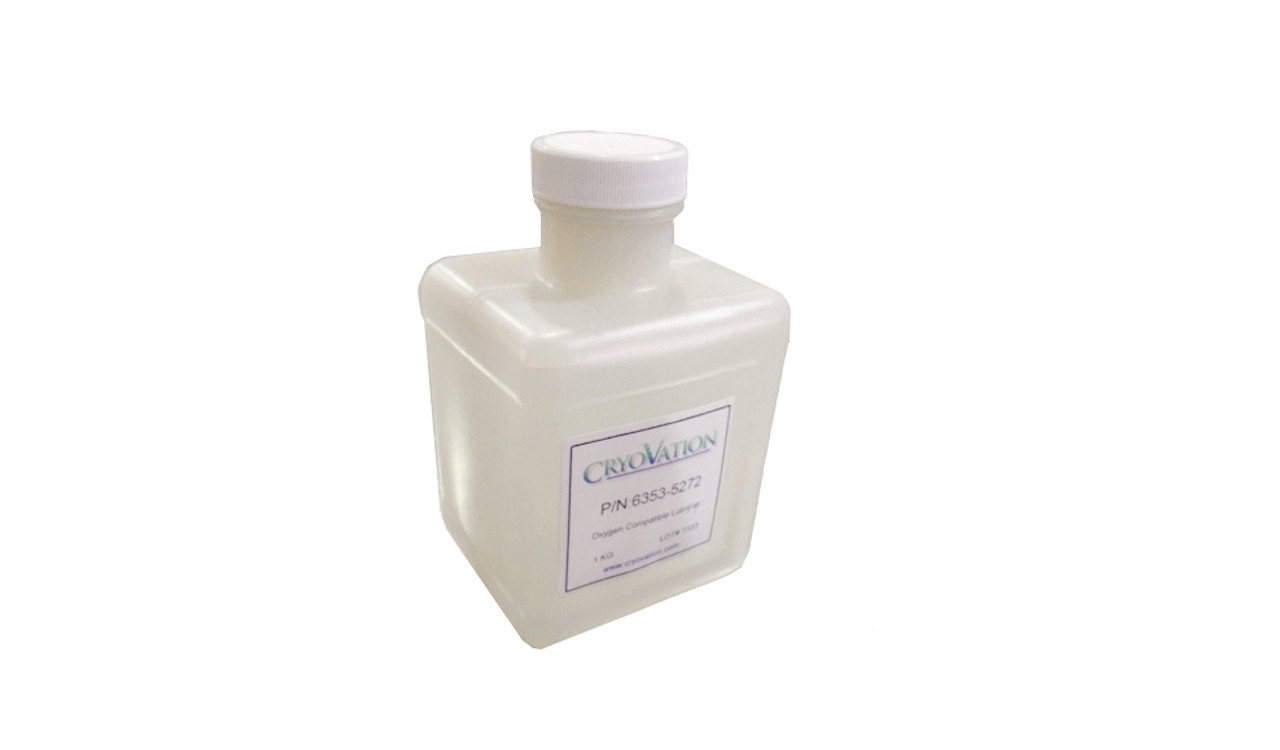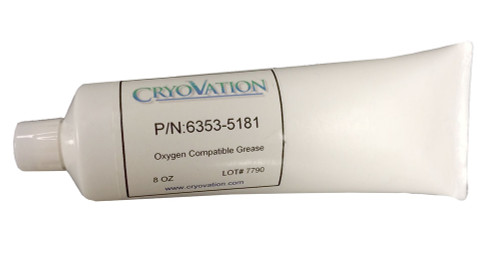Product Description
Oxygen Compatible Vacuum Oil, 1 Kg. or .5 liter jug
- see below oil capacity chart for common models*
- will mix with Dupont's Krytox HE-1600 and Fomblin's 25/6 and other PFPE fluids**
Alcatel 2033 = 3.6 liter
Alcatel 2021 = 1 liter
Kinney KC-8 = 1.3 liter
Kinney KC-15 = 2.84 liter
Kinney KC-30 = 4 liters
Leybold SV10-16 = .5 liter
Leybold D16B = 1 liter max
Leybold SV40 / SV65 = 2 liter max
Leybold SV 200 = 9 liter max
Leybold SV 300 = 11.5 liter max
Leybold D25B = 1.5 liter max
** we recommend varifying before changing or mixing vacuum pump fluids
* these figures are for reference only, please refer to your manual if there are any questions
MSDS Info below . . . . .
1. Substance/Company IdentificationMATERIAL IDENTIFICATION: Inland geminYe PFPE OIL
GRADE: All grades of Inland geminYe Oil
PRODUCTS:
geminYe06
geminYe14
geminYe16
geminYe25
2. Composition/ IngredientsCAS NUMBER: 60164-51-4
CHEMICAL NAME: Perfluoroalkylether
CHEMICAL FORMULA: CF3-[(O-CF(CF3)-CF2)n-(O-CF20)m]-O-CF3
3. Potential Health EffectsSkin contact may cause reddening of the skin. The product was not a skin irritant
or skin sensitizer in a 100 person human patch test.
Based on data from animal tests, eye contact may cause eye irritation with
discomfort, tearing, or blurring of vision.
Inhalation of fluorine containing compounds released as decomposition products
from overheated or burning product may cause lung irritation and pulmonary
edema which require medical treatment.
CARCINOGENICITY INFORMATION:
None of the components present in this material at concentrations equal to or
greater than 0.1% are listed by IARC, NTP, OSHA, or ACGIH as a carcinogen.
4. First Aid MeasuresEye Contact:In case of contact, immediately flush eyes with plenty of water for at least 15 minutes. Call a physician.
Skin Contact:The compound is not likely to be hazardous by skin contact but cleansing the skin after use is advisable.
Inhalation: If inhaled, remove to fresh air. If not breathing, give artificial respiration. If breathing is difficult, give oxygen. Call a physician.
Ingestion:If swallowed, do not induce vomiting. Immediately give 2 glasses of water. Never give anything by mouth to an unconscious person. Call a physician.
Notes to Physicians
Activated charcoal mixture may be administered. To prepare activated charcoal mixture, suspend 50 grams activated charcoal in 400 ml water and mix thoroughly. Administer 5 ml/kg, or 350 ml for an average adult.
5. Fire Fighting Measures FLASH POINT: Does not ignite
Method: PMCC
Non-combustible
EXTINGUISHING MEDIA: As appropriate for combustibles in area.
SPECIAL EXPOSURE HAZARDS IN A FIRE: The product is not flammable.
FIRE FIGHTING INSTRUCTIONS:
Wear self-contained breathing apparatus. Wear full protective equipment.
Decomposition at flame temperatures may form toxic fluorine compounds. Avoid breathing decomposition products.
6. Accidental Release MeasuresSAFEGUARDS (personnel)
Note: Review fire fighting measures and handling (personnel) sections before proceeding with clean-up. Use appropriate personal protective equipment during clean-up
SPILL CLEAN UP
Soak up with sawdust, sand, oil dry or other absorbent material. Shovel or sweep up.
ACCIDENTAL RELEASE MEASURES
Place in container for disposal. Remove source of heat and flame.
7. Handling and StorageHandling: Perfluoropolyether oils are considered to be inert and of low toxicity. However, as with all lubricants it is important to observe correct hygiene practices. Avoid contact with eyes. Avoid contact with skin. Wash thoroughly after handling.
Storage: Keep container tightly closed. Do not store or consume food, drink or tobacco in areas where they may become contaminated with this material.
Keep away from heat and flames to avoid decomposition products.
8. Exposure Controls/Personal Protection: ACGIH Threshold Limit Value (8 hr. time weighted average):
None established
OSHA Permissible Exposure Limit Value (8 hr. time weighted average):
None established
Engineering Controls:
Keep container tightly closed.
Use ventilation when the oil is heated above 550 degF. Keep away from heat and flames.
Personal Protective Equipment:
Eye/Face Protection: Wear safety glasses or coverall chemical splash goggles.
Respirator: Wear NIOSH approved respiratory protection as appropriate.
Protective Clothing: Where there is potential for skin contact have available and wear appropriate, impervious gloves, apron, pants, and jacket
9. Physical & Chemical PropertiesFORM: Liquid, viscous oil
PH: Neutral
ODOR: Odorless
SOLUBILITY in WATER: Not soluble
SPECIFIC GRAVITY: 1.86-1.91 @ 24 ºC (75ºF)
POUR POINT: -57 to -37.7 deg C
COLOR: Colorless
10. Stability & ReactivityCHEMICAL STABILITY: Stable
INCOMPATIBILITY with Other MATERIALS: None reasonably foreseeable.
DECOMPOSITION: Heating above 350 deg C may form potentially toxic fluorine compounds. Depolymerization may occur in the presence of some metal oxides at temperatures above 288 deg C. Decomposition occurs at increasing rates as temperature is raised above 355 deg C
POLYMERIZATION: Polymerization will not occur.
11. Toxicological InformationANIMAL DATA:
Inhalation 4 Hour ALC: >19.54 mg/l in rats
Skin Absorption ALD: >17,000 mg/kg in rabbits
Oral ALD: >25,000 mg/kg in rats
The product is a mild skin and eye irritant, but is not a skin sensitizer in tests on animals. A single inhalation exposure produced nonspecific effects such as respiratory irritation. Exposure to thermal decomposition products produced irritation, irregular respiration, tremors and increased liver weight. Repeated inhalation exposures to 10, 100, or 1000 mg/m3 caused increased lung weights and microscopic particle-laden macrophages in the lungs and lymphs nodes; this was an expected pulmonary response to high aerosol concentrations of an inert material. No animal test reports are available to define carcinogenic, developmental, or reproductive hazards. Tests have shown that the product did not cause genetic damage in bacterial cell cultures.
12. Ecological InformationNo ecotoxicological information is available for this material.
13. Disposal ConsiderationsWaste Disposal: Treatment, storage, transportation, and disposal must be in accordance with applicable Federal, State/Provincial, and Local regulations. Do not flush to surface water or sanitary sewer system.
14. Transport ClassificationShipping Class: Not regulated as a hazardous material by DOT, IMO, or IATA.
15. Regulatory InformationTSCA Inventory Status: Reported/Included
TITLE III HAZARD CLASSIFICATIONS SECTIONS 311, 312
Acute: Yes
Chronic : No
Fire: No
Reactivity: No
Pressure: No
16. Other Information
NPCA – HMIS Rating
|
HEALTH |
1 |
|
FLAMMABILITY |
0 |
|
REACTIVITY |
0 |
|
SPECIAL HAZARD |
NONE |







